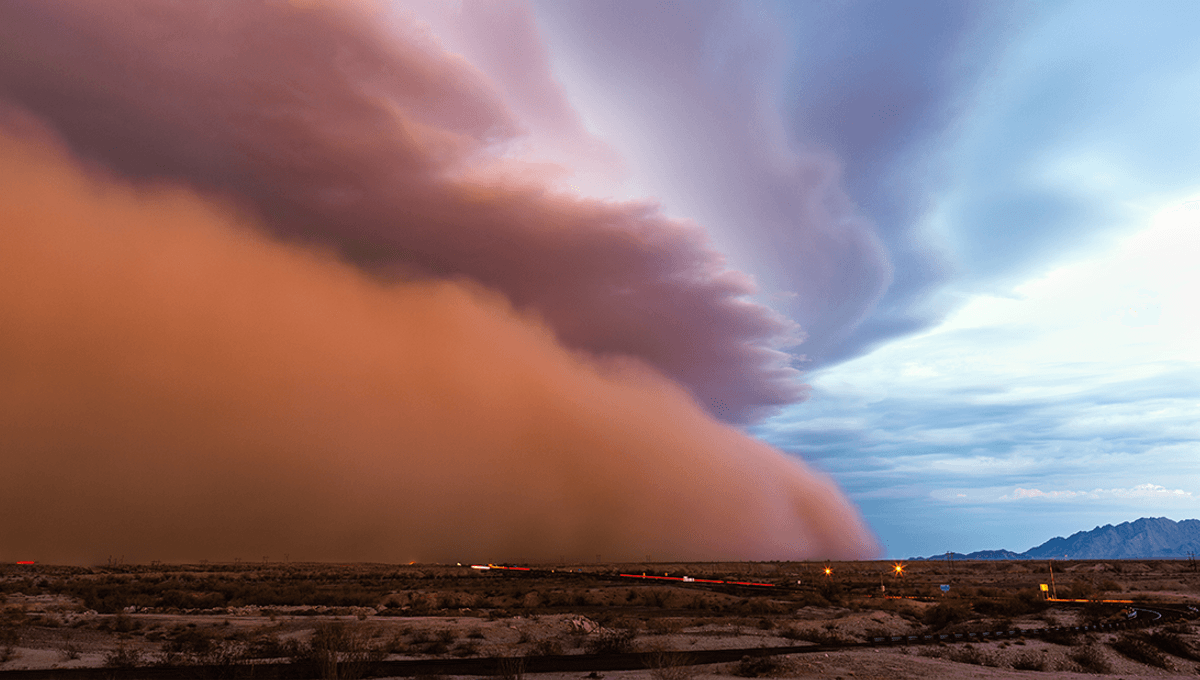
A giant haboob from the Sahara desert is about to reach the southeastern USA, predicted to hit Texas and Florida on Wednesday.
Haboobs are a regular occurrence in the Sahara desert between May and October, particularly in June, as thunderstorms kick dust up high into the atmosphere.
“Haboobs result from a microburst – an intense column of sinking air within a thunderstorm, which, as it hits the ground, spreads out in all directions and carries sand or dust particles at speeds of up to 60 miles per hour,” the Royal Meteorological Society explains. “The lofted particles can reach heights of 5,000 feet [1,524 meters] and can extend up to 100 miles [161 kilometers] wide.”
This particular haboob – sometimes referred to as the Saharan Air Layer – is a particularly large one, and is expected to reach the US coast before dispersing.
“Haboobs happen over Africa. This is a grand-scale haboob,” Jason Dunion, a hurricane scientist at NOAA, told NPR. “It’s about the size of the lower 48 states, and it contains a lot of dry air and a lot of dust, as well. And it makes its way completely across the Atlantic. It’s traveled about 4,000 miles [6,437 kilometers] so far.”
“Now that we’re ramping up into the peak season of these dust outbreaks, it’s about every three to five days that another one comes off the coast. So we usually get several impacts over the peak of the hurricane season,” Dunion added.
While the plume of dust will lose density as it travels over the Atlantic Ocean, Joseph Prospero, professor emeritus at the University of Miami Center for Aerosol Science and Technology, told the New York Times that residents in Florida and other Gulf Coast states should expect the sky’s color to change a little, as the red dust scatters sunlight.
So is all that dust harmful to your health?
“It depends on the concentration and the altitude,” The Copernicus Atmosphere Monitoring Service explains, adding that it is best to refer to local air quality monitoring agencies for alerts. “High altitude dust transport is less likely to have a significant impact on air quality at the surface. But important dust clouds at surface levels bring particulate matter, coarse and fine, worsening air quality and posing respiratory or even cardiovascular risks.”
“Saharan dust does transport microorganisms, including pathogens,” they add. “This shouldn’t be a reason for alarm as airborne virus and bacteria are a part of the atmosphere. As we all have experienced with the COVID-19 pandemic, whether it can be dangerous for health is a matter of concentration of pathogens.”
These haboobs can of course affect the weather as they travel, throughout the summer months.
“The Saharan Air Layer (SAL) is another significant seeding phenomenon affecting tropical storms. It is a mass of dry, mineral-rich, dusty air that forms over the Sahara from late spring to early fall and moves over the tropical North Atlantic every 3-5 days at speeds of 22-55 mph (10-25 meters per second),” the Atlantic Oceanographic & Meteorological Laboratory explains.
“These air masses are 1-2 miles [1.6-3.2 kilometers] deep and exist in the lower troposphere. They can be as wide as the continental US and have significant moderating impacts on tropical cyclone intensity and formation because the dry, intense air can deprive the storm of moisture and wind shear can interfere with its convection. However, disturbances on the periphery of the Saharan Air Layer can receive a boost in their convection and spin.”
The immediate effects are unlikely to be more severe than making your car a bit dusty and grimy, but the storm could impact the local weather.
“There’s a lot of dry air, and you don’t feel that dry air, but the clouds feel it because as they grow and form thunderstorms, they run into that dry air and they just collapse,” Dunion, who was in Puerto Rico as such a storm hit, added to the New York Times. “They get stifled. So as this comes through to a place like Puerto Rico, you’re going to tend to have fewer thunderstorms. It’s going to probably be one of our hotter days. And very hazy. The haze is incredible.”
The storm is expected to push into the Gulf of Mexico before potentially turning the skies hazy from Florida to Texas, possibly until Friday.
Source Link: Sun Filtered By Dust In Florida As Haboob The Size Of 48 States Approaches The US